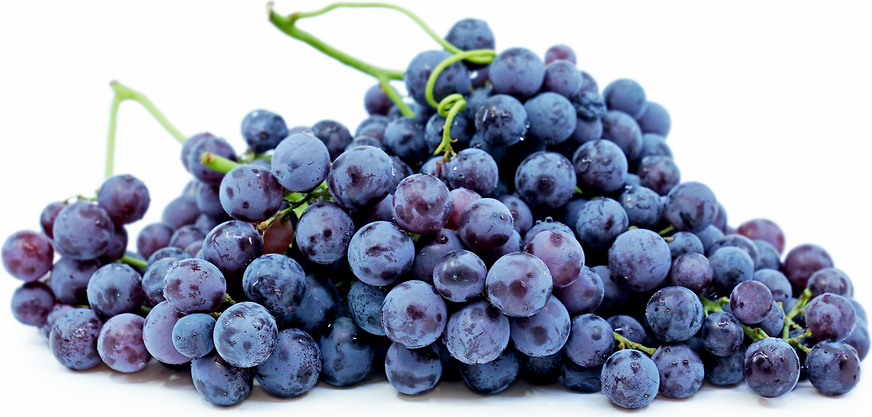


Muscat de Hamburg Grapes
Estimated Inventory, cs : 0
Description/Taste
Muscat de Hamburg grapes are medium to large berries, growing in loose bunches, and have an oval to round shape. The skin is semi-thick, smooth, and taut, ranging in color from dark red, blue, to almost black, and is covered in a powdery and waxy, blue-gray bloom. Underneath the surface, the translucent flesh is aqueous, soft, and dense, containing a few small seeds. Muscat de Hamburg grapes are aromatic and have low acidity mixed with a high sugar content, developing a sweet, musky, and floral flavor with subtle notes of honey, apricots, and pears.
Seasons/Availability
Muscat de Hamburg grapes are available in the late summer through early fall.
Current Facts
Muscat de Hamburg grapes, botanically classified as Vitis vinifera, are a sweet, floral variety belonging to the Vitaceae family. Globally, over two hundred cultivars are labeled under the muscat name, and the muscat grape family is believed to one the oldest, traceable grape lineages in existence. Muscat grapes are known for producing true, grape-flavored wines, but unlike the more well-known cultivars, Muscat de Hamburg grapes are favored as a table grape. Muscat de Hamburg grapes are also known by thirty different names, including Black Muscat, Muscat Hamburg, and Black Hamburg, and are primarily consumed fresh, juiced, or dried. The variety is sometimes grown for winemaking in select regions around the world, but many winemakers consider the grape to be too sweet and mild on its own for quality wine.
Nutritional Value
Muscat de Hamburg grapes are an excellent source of vitamins A and C, antioxidants that strengthen the immune system, boost collagen production within the skin, and reduce inflammation. The grapes are also a good source of minerals, including calcium, iron, and magnesium, and contain some vitamin K.
Applications
Muscat de Hamburg grapes are best suited for raw applications as their sweet, juicy nature is showcased when consumed fresh, out-of-hand. The variety is primarily viewed as a table grape, served as a snack, dessert, or appetizer. The grapes can also be used as a topping over cakes, ice cream, and desserts, paired with cheeses, dried fruits, and nuts on appetizer plates, juiced and used to flavor sparkling beverages and cocktails, or fermented to produce aromatic wines. In addition to fresh applications, Muscat de Hamburg grapes can be cooked into jams and jellies or dried for extended use. Muscat de Hamburg grapes pair well with chocolate, cheeses such as brie, halloumi, and goat, fruits such as strawberries, pears, and citrus, almonds, and mint. Whole, unwashed bunches of Muscat de Hamburg grapes will keep 1 to 2 weeks when stored in a ventilated container in the refrigerator.
Ethnic/Cultural Info
In France, Mont Ventoux, situated between the Alps and the Mediterranean Sea, is known for providing rich soil to ancient vineyards in the sloping foothills. The vineyards have been cultivating grapes used in winemaking for centuries, and in the 19th century, Muscat de Hamburg grapes were planted to develop quality flavored table grapes. Over time, Muscat de Hamburg grapes became one of the most popular varieties grown in the region, and many growers attributed the variety’s unique flavor to the soil of Mont Ventoux. In 1997, the variety was granted an appellation d’origine under the name Muscat du Ventoux. The appellation d’origin (AOC), also known as a controlled designation of origin, protects the region-specific grapes, and growers have to abide by strict cultivation standards to sell the protected cultivar. To be labeled as Muscat du Ventoux, Muscat de Hamburg grape bunches are hand-harvested with scissors, measured to a specific weight and size, and can only be gathered in a certain window of time to prevent fraudulent bunches from being sold. In the modern-day, over 250 growers are producing Muscat du Ventoux, and the variety encompasses more than half of the available cultivation space for table grapes in the region.
Geography/History
Muscat de Hamburg grapes were created in Europe from a cross between the muscat of alexandria and schiava grossa varieties. The grape’s country of origin is disputed among experts, with some tracing the variety to Germany while others believe it was developed in England. In 1850, Muscat de Hamburg grapes were released to commercial markets and were successfully cultivated as a table grape variety. Today Muscat de Hamburg grapes are still grown in Europe, especially in France, England, Greece, and Eastern Europe, and are cultivated in Australia, China, and Israel. The variety is also grown in California, Washington, Oregon, Texas, and Virginia of the United States as both a table grape and varietal for winemaking. When in season, Muscat de Hamburg grapes can be found through select growers at specialty grocers and farmer’s markets. The Muscat de Hamburg grapes featured in the photograph above were grown through Penryn Orchard Specialties, located in Northern California.
Recipe Ideas
Recipes that include Muscat de Hamburg Grapes. One




